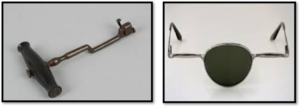The First Gifted Dog
By Shany Dror
In this article we will review some of the world’s most dogs, and their contribution to science. We will also use the example of “fast mapping” to show how the scientific path turns and twists when old findings are observed under a new light.
The first gifted Dog
Rico, an 8-year-old male border collie from Germany was the first recorded case of a dog with an extensive vocabulary of object names. His owner reported that he knew the names of 200 objects, most of which were children toys. On top of this impressive vocabulary, Julian Kaminski and her colleagues1 from the Max Planck Institute claimed that Rico was able to learn the names of new objects after hearing them only once, a process known in infants as “fast mapping”.
What is fast mapping?
Infants learn the meanings of new words in various ways. In the case of fast mapping, the infant quickly associates a new word to a novel object by excluding alternative associations with familiar objects.
For example, which of the three objects below do you think is a Toky?

You probably didn’t choose the umbrella or the broom.
Questions that arose from the study with Rico:
- How many object names can a dog learn?
- When hearing the word “sock”, did Rico understand that his owner was referring to the object or did he understand the word sock as the command: “fetch the sock”?
- When children learn a new word like “ball” they understand that it can be used to refer to similar objects in this category. But do dogs understand this?
- Can only border collies or dogs from working breeds learn names of objects?
The world’s "smartest" dog
In 2011 scientists and dog lovers alike were amazed when John W. Pilley, a professor from Wofford College, published a research article2 about his female border collie, Chaser. In four experiments Pilley attempted to answer some of the questions raised by the study on Rico, as he presented Chaser’s ability to:
- Learn a massive vocabulary of 1022 toy names (after three years of intensive training).
- Perform multiple actions on the same object. She could touch an object with her nose, her paw, or retrieve it. This showed that Chaser understood the words referred to the object’s name and not to the command of retrieving them.
- Be trained to categorize objects, such as balls and frisbees.
- Supposedly fast map new names to novel objects thereby supporting the findings from the study with Rico.
But did Chaser and Rico actually perform fast mapping (learning a new object name after hearing it once)? Could it be that they were only excluding the familiar toys and retrieving the new toy, without the need to learn its name?
A small dog leads to big findings
The answers to these questions came from a surprising source, Bailey, a 12 years old Yorkshire Terrier. At the time, Bailey was te only cases of gifted dogs, that did not belong to a working dog breed.
Like Rico, Bailey learned the names of 117 toys during play sessions with her owner, without the extensive training efforts invested in Chaser. Bailey, like Rico and Chaser, was able to select a new toy upon hearing a new word, by excluding all the other familiar toys.
But then the experimenters tested her in a new situation. They presented her with two items, which she supposedly learned using fast mapping, and asked her to retrieve one of them3. Sounds confusing? Here’s an example:
Which of the following items do you think is the Sliko?

Remember the test you did before? Now, which of these two items is the Toky?

Did you choose the object on the right? That’s because during the first test you didn’t only exclude the known objects as possible solutions but also created an association between the new word Toky and the new object. Bailey however, was unable to complete this task.
So, what does this mean?
The findings from Bailey’s study shed new light on the findings from Rico and Chaser. It now seems that dogs are able to use exclusion strategies when retrieving new objects but they may not learn the new words as names of the new objects3.
What else have do know about gifted dogs?
Gifted dogs are very rare, that’s why there are not many studies on them. The studies that do exist often include only a single dog. The question of fast mapping is only one of many exciting things that we can learn from and about genius dogs. In the next article we will present more surprising findings.
References
1Kaminski, J., Call, J., Fischer, J., 2004. Word Learning in a Domestic Dog : Evidence for “ Fast Mapping .” Science (80-. ). 304, 1682–1683.
2Pilley, J.W., Reid, A.K., 2011. Border collie comprehends object names as verbal referents. Behav. Processes 86, 184–195.
3Griebel, U., Oller, D.K., 2012. Vocabulary learning in a Yorkshire terrier: Slow mapping of spoken words. PLoS One 7. https://doi.org/10.1371/journal.pone.0030182